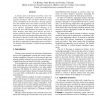Free Online Productivity Tools
i2Speak
i2Symbol
i2OCR
iTex2Img
iWeb2Print
iWeb2Shot
i2Type
iPdf2Split
iPdf2Merge
i2Bopomofo
i2Arabic
i2Style
i2Image
i2PDF
iLatex2Rtf
Sci2ools
EUROMICRO
2004
IEEE
2004
IEEE
Determination of Aggregation Points in Wireless Sensor Networks
A primary goal in the design of wireless sensor networks is lifetime maximization, constrained by the energy capacity of batteries. One well known method to reduce energy consumption in such networks is message aggregation. This method reduces the number of messages transmitted in the network, thus extending its lifetime. In order to be effective, aggregation requires messages to be delayed in their path throughout the network. This technique, therefore, must define where and for how long a message should be delayed. This paper shows how aggregation points and corresponding aggregation delays can be determined so that the overall energy efficiency of the system is improved. An algorithm is presented which allows the efficient computation of aggregation points and delays. The benefits of the algorithm is verified through simulation experiments.
Aggregation Points | Aggregation Requires Messages | EUROMICRO 2004 | Message Aggregation | Software Engineering |
| Added | 20 Aug 2010 |
| Updated | 20 Aug 2010 |
| Type | Conference |
| Year | 2004 |
| Where | EUROMICRO |
| Authors | Utz Roedig, André M. Barroso, Cormac J. Sreenan |
Comments (0)

